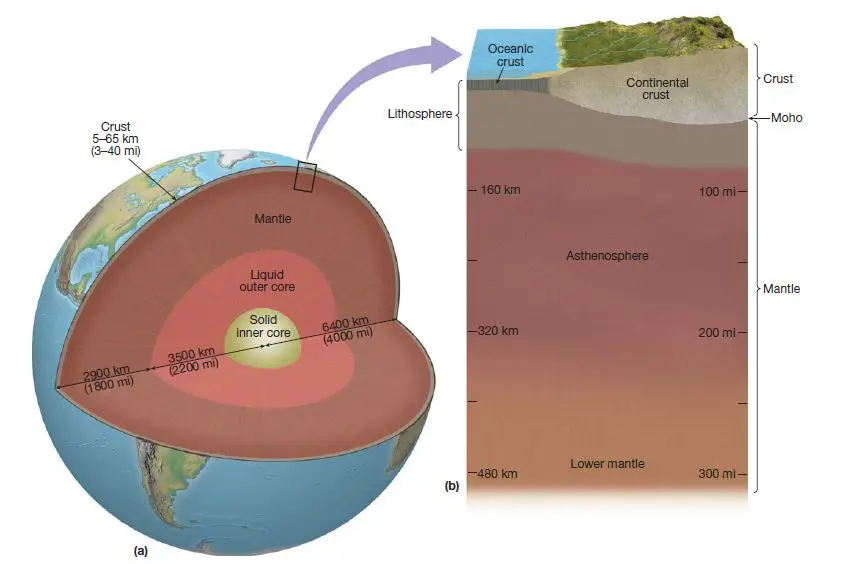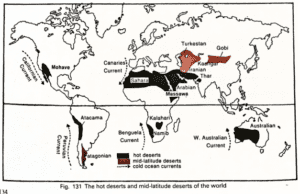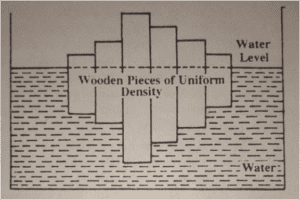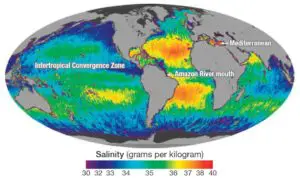Table of Contents
THE STRUCTURE OF EARTH | UPSC – IAS | Geography Optional
Physical conditions of the Earth’s Interior | UPSC – IAS
Our knowledge of the Earth’s Interior is based largely on indirect evidence. No human activity has explored more than a minute fraction of the vastness beneath the surface. No one has penetrated as much as one-thousandth of the radial distance from the surface to the center of Earth;
- The deepest existing mine shaft extends a mere 3.8 kilometers (2.4 miles). Nor have probes extended much deeper;
- The deepest drill holes from which sample cores have been brought up have penetrated only a modest 12 kilometers (8 miles) into Earth.
Image Explanation – The vertical structure of Earth’s interior. (a) Below the thin outer crust of Earth is the broad zone of the mantle, and below the mantle are the liquid outer core and the solid inner core. (b) Idealized cross section through Earth’s crust and part of the mantle. The crust and uppermost mantle, both rigid zones, are together called the lithosphere—the “plates” of plate tectonics. In the asthenosphere, the mantle is hot and therefore weak and easily deformed. In the lower mantle, the rock is generally rigid again.
Earth scientists, in the colorful imagery of writer John McPhee, “are like dermatologists: they study, for the most part, the outermost two per cent of the earth. They crawl around like fleas on the world’s tough hide, exploring every wrinkle and crease, and try to figure out what makes the animal move.
- Even so, a considerable body of inferential knowledge concerning Earth’s interior has been amassed by geophysical means, primarily by monitoring patterns of vibrations transmitted through Earth from earthquakes or from human made explosions.
- Such seismic waves change their speed and direction whenever they cross a boundary from one type of material to another. Analysis of these changes, augmented by related data on Earth’s magnetism and gravitational attraction, has enabled Earth scientists to develop a model of Earth’s internal structure.
Earth’s Hot Interior | UPSC – IAS
In general, temperature and pressure increase with depth inside Earth, with the highest temperatures and pressures at the center.
- The source of this warmth is largely from the release of energy from the decay of radioactive elements (in much the same way as the decay of radioactive material supplies the warmth to power a nuclear power plant).
- As we will see, it is the transfer of heat from Earth’s interior that drives many Earth processes such as plate tectonics and volcanism
Earth’s Interior – The Crust | UPSC – IAS
The crust, the outermost shell, consists of a broad mixture of rock types. Beneath the oceans the crust has an average thickness of only about 7 kilometers (4 miles), whereas beneath the continents the thickness averages more than five times as much, and in places exceeds 70 kilometers (40 miles).
- Oceanic crust is thinner but is comprised of denser (“heavier”) rocks than continental crust. In general within the crust there is a gradual increase in density with depth. Altogether, the crust makes up less than 1 percent of Earth’s volume and about 0.4 percent of Earth’s mass.
- At the base of the crust there is a significant change in mineral composition. This relatively narrow zone of change is called the Mohorovicˇic´ discontinuity, or simply the Moho for short, named for the Yugoslavian seismologist Andrija Mohorovicˇic´ (1857–1936) who discovered it.
Earth’s Interior – The Mantle | UPSC – IAS
Beneath the Moho is the mantle, which extends downward to a depth of approximately 2900 kilometers (1800 miles). In terms of volume, the mantle is by far the largest of the four layers. Although its depth is only about one half the distance from the surface to the center of Earth, its location on the periphery of the sphere gives it a vast breadth. It makes up 84 percent of the total volume of Earth and about two-thirds of Earth’s total mass. There are three sublayers within the mantle, as Image shows.
- The uppermost zone is relatively thin but hard and rigid, extending down to a depth of 65 to 100 kilometers (40 to 60 miles)—somewhat deeper under the continents than under the ocean floors. This uppermost mantle zone together with the overlying oceanic or continental crust is called the lithosphere. “lithosphere” refers specifically to the combination of the crust and upper rigid mantle—and as we’ll see shortly, it is large pieces of the lithosphere that are the “plates” of plate tectonics. Beneath the rigid layer of the lithosphere, and extending downward to a depth of as much as 350 kilometers (200 miles), is a mantle zone in which the rocks are hot enough that they lose much of their strength and become “plastic”—they are easily deformed, somewhat like tar. This is called the asthenosphere (“weak sphere”). Below the asthenosphere is the lower mantle, where the rocks are very hot, but largely rigid again because of higher pressures.
Earth’s Interior – The Inner and Outer Cores | UPSC – IAS
- Beneath the mantle is the outer core (Image), thought to be molten (liquid) and extending to a depth of about 5000 kilometers (3100 miles). The innermost portion of Earth is the inner core, an evidently solid (because of extremely high pressure) and very dense mass having a radius of about 1450 kilometers (900 miles). Both the inner and outer cores are thought to be made of iron/nickel or iron/silicate.
- These two zones together make up about 15 percent of Earth’s volume and 32 percent of its mass. A common misconception is that the liquid outer core of Earth is the source of molten rock (“magma” and “lava”) that is expelled by volcanoes, but this is not the case.
- Instead, the near-surface mantle is the source for magma, while Earth’s cores are the source of energy that drives the slow movement of hot rock through the mantle toward the surface (through the process of convection).
- This rising hot rock in the mantle is under so much pressure that it remains essentially solid— only when this rising mantle material is very close to the surface is pressure low enough for it to melt.
Earth’s Interior – Earth’s Magnetic Field | UPSC – IAS
Earth’s magnetic field is generated in the outer core: convective circulation within the conductive liquid iron and nickel outer core, spiraling in line with Earth’s rotational axis, induces the magnetic field of our planet through what is sometimes called a geodynamo.
- Interestingly, the strength and orientation of the magnetic field changes over time, and the location of the north magnetic pole does not exactly match the true geographic North Pole.
- The position of the north magnetic pole slowly but continually drifts several tens of kilometers each year—it is currently located at about 86° N, 147° W – but the position of the north magnetic pole can even change significantly during a single day!
- In addition, for reasons that are not completely understood, at irregular intervals of thousands to millions of years, the polarity of Earth’s magnetic field reverses, with the north magnetic pole becoming the south. A record of these magnetic polarity reversals has been recorded in the iron rich rocks of the ocean floor.




